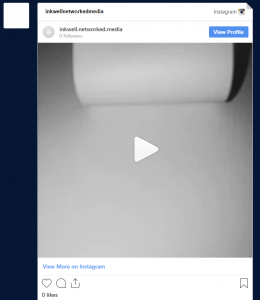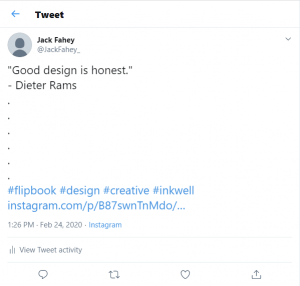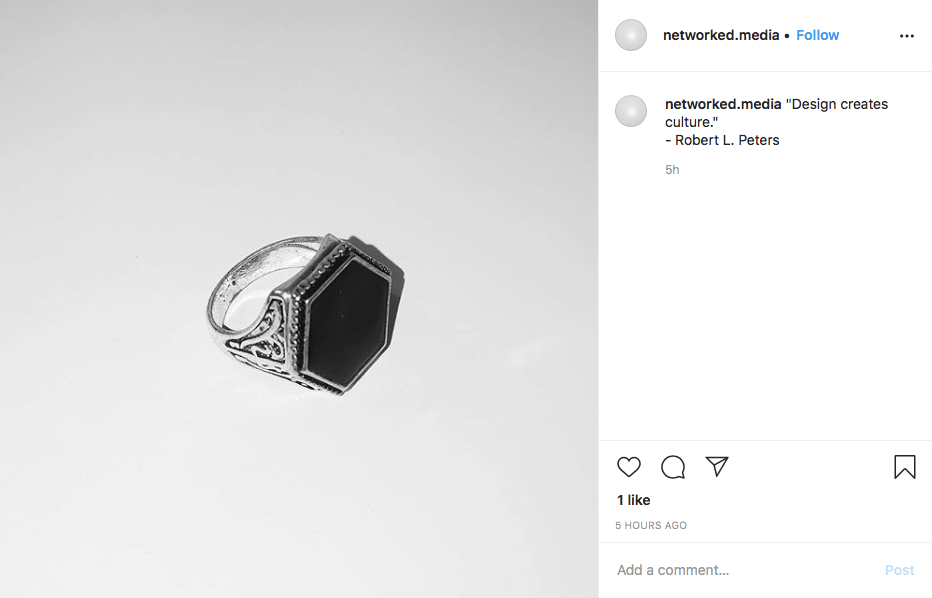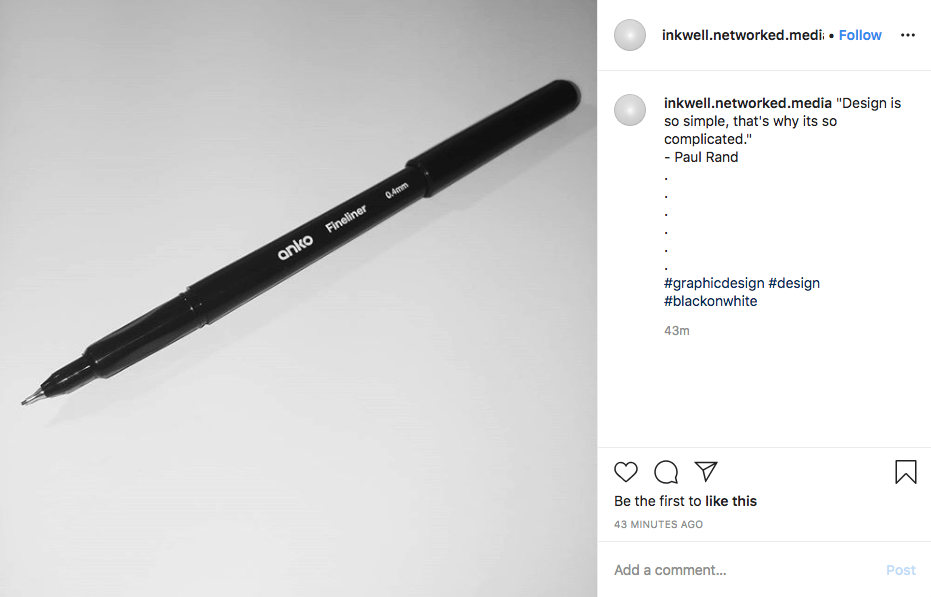Assignment 3 – Report
Name: Jack Fahey | s3382553
I declare that in submitting all work for this assessment I have read, understood and agree to the content and expectations of the assessment declaration – https://www.rmit.edu.au/students/support-and-facilities/student-support/equitable-learning-services
Making Media blog links
Week 5 – Instagram photo
Week 5 – Instagram video
Week 5 – Instagram photo
Week 6 – Instagram video
Week 6 – Instagram photo
Week 6 – Instagram video
This report responds directly to the course prompt:
How do the affordances of Instagram affect the way photos and videos are authored, published and distributed in the network?
Title of report: Instagram, Algorithms and the Rise of Bot Accounts.
Introduction
The Instagram app offers users the ability to post photo and video content whenever and wherever they are, and share that with anyone they want on a global platform. It is however, a rather limited application in terms of functionality on the creative end. Instagram has several heavy constraints around the content that can be created on the app, both from the side of the creative tools available within the software and then also in the terms and conditions of the app (Instagram, 2020). This report will focus on the software related constraints that Instagram imposes on its users and how they promoted commercial content on Instagram. It will detail how the shift from amateur to professional has impacted content creators (Shaw, 2015) and then heavily focus on how it all ultimately lead to the rapidly rising trend of Bot and Spam Accounts populating Instagram and how that currently affects Instagram in 2020.
Background
Affordances are an object’s properties that relay to the user how they can interact with it (Norman, 1988). Instagram’s intended affordances can be explained very simply. It connected users around the world, allowing them to share their own user generated visual content. It has, however, developed significantly beyond that over the decade or so since its inception. In a world connected socially and economically by a world wide network, many people saw an enormous market opportunity within Instagram. This is the biggest shift in perceived affordances within the app, and its the reason Instagram has become a massive multi-national corporation. The next step for Instagram was professional, targeted content. This started off slowly, with the Instagram content itself still being the primary driver, but soon new affordances revealed were found by developers, entrepreneurs and content creators alike. Instagram profiles could be anything, a shop, a photo essay, an advertisement for a business, the limit was only whatever someone could imagine. And so, Instagram become the home of professional, carefully authored content that was published with the express purpose of capitalistic gain and aimed at achieving an incredibly wide reach.
Instagram immediately embraced the professional content creators. It curated feeds to more accurately display hashtags that your profile was already following, it added things like ticks for verified users and it continued to update the software to add features like IGTV and Instagram stories, which is currently the most used element of the platform with over 500 million stories viewed daily (Hutchinson, 2019). An inevitable problem did eventually arise though; bot accounts. These profiles upload content constantly, and are often automated remotely or run by an algorithm. They flood comments asking users to look at their stories or view their profile, and will constantly post photos with hundreds of Instagram users names tagged in the caption to gain viewers (Alvarez, 2019). These accounts were posting far too often and being created far too frequently for human’s to track them, the manpower required would be astronomical. Instagram’s solution to this problem was machine learning and algorithm based detection. Originally, the accounts were incredibly easy to spot, and so they were rather easy to block and delete. As they became more proficient at remaining undetected however, Instagram’s algorithm had to find new ways to spot them. And, as was discovered during my own media making throughout this assignment, the new detection system certainly isn’t perfect.
Evidence
The media making process throughout this assignment was quite a unique experience, I had never encountered the likes of shadow banning, Instagram’s detection algorithm or anything on my personal account being blocked. The first profile I created for this assignment (which can still be viewed here) was banned from posting by Instagram. Even several days after I stopped using it, the account still doesn’t let me upload anything to the profile, however my likes and comments still function. Throughout my blogs, I explored a few possible reasons why I in particular was blocked, for example in my post about a video I captured of my lamp (which can be read here) that perhaps it was a combination of frequency of upload and the kind of content I was uploading. During my research, I found that many bot accounts are much more subtle than what I was aware of. These bot accounts aren’t entirely machine ran, and actually are more like automated processes that handle content upload schedules and hashtag optimization for traditional Instagram Branded accounts (Moore, 2020). These bot accounts are often employed by accounts that are trying to build a following on their account as quickly as possible so the user can sell their account to someone else for a profit. Some key features that the Instagram algorithm might label as suspicious behaviour are; constant and frequent uploads (especially on a new account) and specific content related key terms. Whatever is currently popular to sell on Instagram would be high up on the list of flagged content, and perhaps my combination of posts highlighting individual objects that could be sold on Instagram (a pen, a lamp, a keyboard, a ring etc) and the hashtags that I labelled them with (fashion, culture, design, creative etc) lead the algorithm to misidentify me as a spam account. As discussed in my initial blog (see here) I also restricted the account to be somewhat uniform in an attempt to re-create a realistic “aesthetic focused” Instagram account and make the profile seem more “human”. This may have had unintended consequences, making Instagram think that I was producing redundant and similar content in an attempt to post frequently like these bot accounts often will.
One thing is for sure, it is incredibly difficult to spot these modern and subtle spam and bot accounts. While people can easily tell the difference subconsciously between professionally produced content and amateur content (Shaw, 2015), can we decipher which accounts are run by real, professional creators, and which are automated by machine learning and algorithm based posting?
Evaluation
Instagram’s affordances heavily impact the way that user generated content is authored and how it is published. Instagram’s structural format and limited functionality within the camera portion of the app (as discussed further in my first blog post) heavily constrain the physical dimensions and layout of all content posted to Instagram. As discussed throughout this report though, the unintended constraints and affordances that have been identified within the Instagram App lead to a rise of bot accounts and, at this current rate, there will only continue to be more. Bot usage has risen to 9.5% from 7% in 2015 and there may be up to 95 million bot accounts currently on Instagram (Williams, 2018). This data is a year old, so the numbers are probably even higher in 2020. In his article AFFORDANCE, CONVENTIONS, AND DESIGN Donald Norman discusses his notion of constraints and separates three distinct forms named Physical, Logical and Cultural (Norman, D 1999). It is the cultural constrains, defined as “conventions shared by a cultural group” (Norman, 1999) that most heavily impact Instagram’s content, and produced the sea of spam bots populating Instagram today. In the modern world of instant connection and networking across countries, humans require constant and immediate access to desired content (Patel, 2014). Instagram was a step in the right direction, but the frequency and accuracy that is required of content creators is unmanageable for those attempting to become professionals. And so, apps and bots were developed to do a lot of the monotonous tasks, which lead to the sophisticated and nigh undetectable bots that we have now. Norman even warned of this in his 1999 article, stating “The power of constraints has largely been ignored … the concept has caught on, but not always with complete understanding.” (Norman, 1999). The cultural constraints surrounding Instagram have produced completely unintended results, and because this wasn’t foreseen during development, Instagram is scrambling to find an algorithm based solution. In my opinion, the software just isn’t sophisticated enough to be able to detect these bots with proper accuracy and so, as was the case with my initial Instagram account, it will continue to mislabel genuine profiles as bots and bot profiles as genuine until it has developed to a point where it is truly useful and efficient.
Conclusion
This report does have some drawbacks, the biggest of being that Instagram itself is very reluctant to openly discuss how its algorithm works and what it is aiming to detect. Therefor, much of the information on how it functions is speculative rather than factual. This report deals with fairly recent subject matter and takes a very designer focused critique of the app, which means that specific academic resources available are relatively few and difficult to find.
Despite this, the strengths of this report are numerous. It is one of the few academically structured inquiries into this subject matter and will hopefully open discussion further on the subject matter. Taking a designer focused lens to the Instagram app and specifically detailing the constraints that lead to the massive bot profile trend is a new, niche approach to exploring the cultural impacts of Instagram on both user behaviour and content creation. The report also draws upon actual experience in a content creation setting, with my own personal profile being blocked due to the algorithm, and so that lends a unique and anecdotal insight into the Instagram algorithm based bot detection.
The aim of this report was to identify key software affordances and constraints that are present within the Instagram app that lead to the development of bot accounts throughout Instagram. In this sense, it was a successful endeavor.
References:
Alvarez, E 2019, Engadget is now a part of Verizon Media, viewed 23 Feb 2020, https://www.engadget.com/2019/04/19/instagram-bots-spam-comments-huge-booty-masturbate-verified-badges/
Hutchinson A, 2020, Instagram Stories is Now Being Used by 500 Million People Daily, viewed 23 Feb 2020, https://www.socialmediatoday.com/news/instagram-stories-is-now-being-used-by-500-million-people-daily/547270/
Instagram 2020, Community Guidelines, Instagram Help Centre, viewed 23 Feb 2020, https://help.instagram.com/477434105621119 [Accessed 23 Feb. 2020].
Moore, E 2020, A Beginner’s Guide to Instagram Automation, Smartproxy, viewed 23 Feb 2020, https://smartproxy.com/blog/a-beginners-guide-to-instagram-automation
Norman, D 1998, The design of everyday things , Basic Book, New York
Norman, D 1999, ‘Affordance, conventions and design (Part 2)’, Nielsen Norman Group, viewed 23 Feb 2020, http://www.jnd.org/dn.mss/affordance_conv.html
Patel, N. 2014, The Psychology of Instant Gratification and How It Will Revolutionize Your Marketing Approach, viewed 23 Feb 2020, https://www.entrepreneur.com/article/235088
Shaw, M 2015, Pro Vs Amateur, and the Instagram Gallery On The New York Times Front Page – Reading The Pictures, viewed 24 Feb 2020, https://www.readingthepictures.org/2015/01/pro-vs-amateur-and-the-instagram-gallery-on-the-new-york-times-front-page/
Williams, R 2018, Instagram may have 95M bot accounts, The Information reports, viewed 23 Feb 2020, https://www.mobilemarketer.com/news/instagram-may-have-95m-bot-accounts-the-information-reports/528141/
















